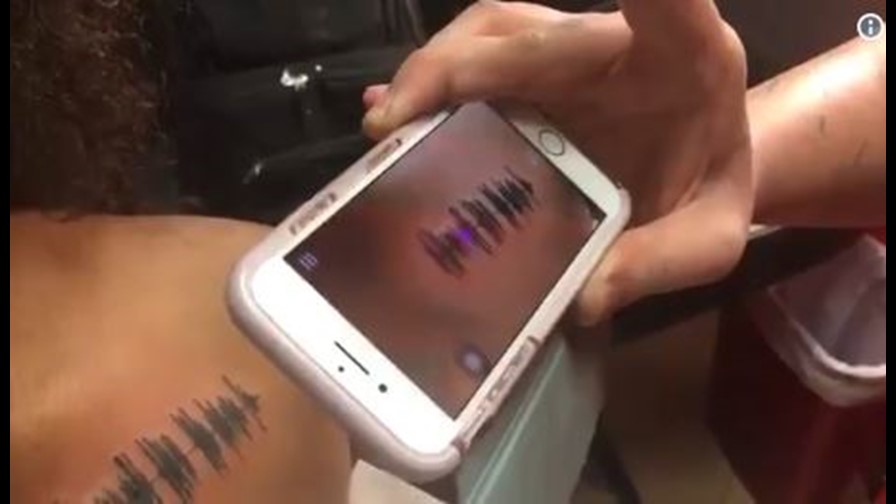Skin motion
« previous post | next post »
Nia Wesley, "Girl's tattoo of late grandma's voicemail can be played with iPhone":
A Chicago singer honored her late grandmother in a unique way.
Sakyrah Morris held on to a voicemail her grandmother sent her just a month before she passed away. She got a tattoo of the voicemail's exact sound waves.
Through technology with a company called Skin Motion, Morris can hold her iPhone camera over the tattoo and hear her grandmother's voice at any moment.
You can learn more about this process on the company's website.
All the information about a sound is in principle encoded in the "waveform", i.e. the time function of deviations from ambient air pressure, and it would certainly be possible to recover the sound from an adequately detailed waveform image. But a tattoo of more than a few tens of milliseconds is not going to be "adequately detailed" for this purpose — a reasonable quality representation of someone's voice will require at least 8,000 samples per second, and substantially more than that for decent fidelity. So if Granny's voicemail is 10 seconds long, we need 100,000 data points or more — and it's obvious that the tattoo has at best got a few hundred.
So how does this actually work?
The company's FAQ doesn't come right out and say, but we can infer the truth:
After the Artist does the tattoo, you can activate it to be played back by the Skin Motion app for $39.99 for the first year of service and $9.99 a year after that. […]
When the Skin Motion app recognizes the shape of the Soundwave it plays back the sound. […]
How does a Soundwave Tattoo work?
A combination of audio processing, image recognition, computer vision, and cloud computing to create a mixed reality experience.
Right. So reading between the lines, what they do is to take your recording along with the image of the tattoo, and store them on a server in the cloud. Then the iPhone or Android app sends the image of the tattoo to the company's program, which recognizes the picture (as one of those that has been "activated"), looks up the corresponding sound, and plays it.
In fact the picture could be anything — a bar code, Granny's fingerprint, a drawing of your favorite musician — though maybe Skin Motion has employees preventing attempts to "register" such images as access keys.
If you want to be able to hear Granny's last voicemail whenever you want, you could avoid the $39.99 + $9.99/year, and just store it on your phone or upload it to the cloud yourself. And if you also want a tattoo of the waveform (or the spectrogram or the pitch contour), you could print out a screen shot from Praat and take it to your favorite tattoo artist. Connecting the two, so that taking a picture of the tattoo plays the recorded sound, would take a bit of programming on your part, but there are app development environments out there…

Chris Phipps said,
January 5, 2018 @ 2:26 pm
One neat trick that they seem to have added is to match the wave form to the recording as it plays (you see a line or something progressing as it plays). So, yes you could use any tattoo, but the line wouldn't match up.
Rebecca Root said,
January 5, 2018 @ 2:27 pm
Actually, there are free apps, like Aurasma, that will do the connecting bit. You can connect any sufficienty unique image with any on-line content. You could get really freaky and take a video of granny, use a screen-shot from it for the tatoo, and then use Aurasma to have the video play when the tatoo is scanned.
Gregory Kusnick said,
January 5, 2018 @ 2:38 pm
If you hold the phone upside down, is it smart enough to play the audio clip backwards?
milu said,
January 5, 2018 @ 3:51 pm
I'm wondering, assuming a smart reader filling in the blanks based on current voice synthesis AI, how many data points per second would be needed to get a realistic result by combining this sort of gross waveform with spectrogram, fundamental frequency, and text transcript?
or to frame the question the other way round, assuming an available (what?) 2,000 data points, how many seconds of an individual's voice could a smart app realistically synthesize?
nerd-eyerolling aside, the fad potential of this sort of tattoo-servicing app is clear as everyone knows what a waveform looks like. spot a "waveform" tattoo a and you know to snap it and "play" it, assuming the associated file was made public.
@ Gregory Kusnick and does flexing and relaxing your trapezius change the playback speed?? :D
[(myl) 32 kb/s lossy encoding gives a decent lo-fi replication of a speech recording. That's 8 kB. So if your 2,000 points encode one byte each (roughly plausible from the pictures), you could get a quarter of a second — except that the result will not make a coherent much less pretty visualization.]
Pickering said,
January 5, 2018 @ 11:09 pm
I'll wait for the app that projects holograms.
Audiowellen-Tattoos – mkln.org said,
January 6, 2018 @ 5:39 am
[…] die tätowierte Audiowellengrafik nur rudimentär mit der tatsächlichen Audioaufnahme zu tun hat. Mark Libermann findet zu Skin Motion klare […]
Andrew Usher said,
January 6, 2018 @ 4:28 pm
Shouldn't this be called a 'scam'? I don't think I would discuss it without labeling it so, because they rely on deceiving (at least most of) their customers and really provide nothing of value.
k_over_hbarc at yahoo.com